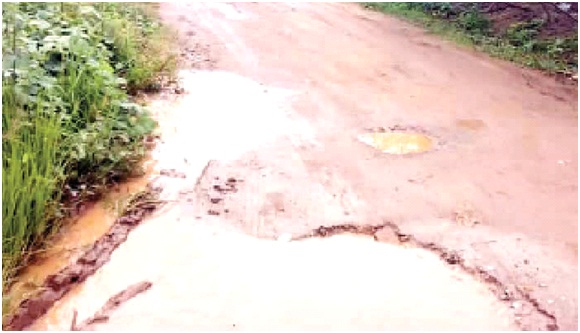WORMS (ARAN)
In many countries especially in the developing nations, about a quarter of all the children die before they are five years old of various forms of preventable diseases. Apart from those dead, many of the living children are sick and dying piecemeal* We can do a lot to stop much of this diseases and reduce the death toll. We can care for children, prevent them from becoming ill and we can cure them when they are ill.
A child can be said to be healthy when he is part of a healthy family. So the role of the family especially’ the mother in child health is vital. A sick child is unhappy and the death of a child is a serious loss to the family so the health of every child is important to the family and the society at large. My parents hyperproliferate in the past for fear of some children dying. But the only Way parents will want smaller families is to prevent their children from dying.
Plenty of good food, clean water, and loving care are paramount for the health of a child than medicine. The immediate environment in which the child, grows is also contributory to the overall health of the child.
The two most common kinds of disease in children are infection and malnutrition. A malnourished child does not eat enough of the right foods while an infected child has germs growing inside him. A well nourished child may lapse into malnutrition in disease states. Some children are both malnourished and infected. The germs that cause infection include insects, worms, bacteria, protozoa, fungi, and viruses. Drugs can help fight these germs in different ways but it is better to stop or prevent a disease that cap be foreseen long before it begins.
Worms are a special form of germs that do not respond to antibiotics. Worm are so common in our community. There many types of worms and children are worst affected in most, cases. Most worms live in the intestine of man and lay eggs which is passed out in stool. These eggs are not visible to the naked, EYES.
Worms cause weight loss, abdominal pain, occasional dysentery. The common types of worm in our community are Threadworm, Trichuris, Hookworm, Roundworm, H.nana. and tapeworm. Hookworm causes blood loss.
Diseases caused by helminths (worms) causes much morbidity in the tropics, many of which may be found in people even years after leaving the tropics. Worm infection is a broad terminology which includes schistosomiasis, liver flukes tapeworm, filariasis etc.
Symptoms and Signs
Blood destruction leading to anaemia
Nutritional imbalance with weight loss.
3.. Creeping skin eruptions in some cases.
Allergic swellings and body itching.
Abdominal . pains with bloating.
Fever in rare cases.
Enlargement of the spleen and jaundice.
Muscle aches
Cough
Vomiting and occasional dysentery
Sweating with yellowish skin.
Itching arms and sometimes rectal prolapse.
Blood in urine in cases of schistosomiasis.
The number of worms living in a child is called the worm load. Worms can infect children and adults alike. A heavy load of worms usually causes symptoms, but a light load of a few worms seldom causes symptoms. It is almost impossible to remove all a child’s worms but we can always remove the bulk of the worm load and cure his symptoms.
Life cycle of the worm entails a part of the cycle inside the human body and the other part outside the human body. The life cycle of the common Hookworm is shown be-low.
This worm multiplies by getting outside a child’s body onto the ground, other worms like tapeworm may go into another animal like the dog or pig. Hookworm live in the intestine of man and stay there by biting into its wall. Each adult hookworm. lays thousands of egg (ova) which are passed down in the child’s stool. When the egg gets to the ground it hatches to become the larva (young worms) it metamorphosis into a second type of larva. This larva must go back into the child through his skin. If this does not take place, the larva dies in a few. days. The larva then waits until the child walks bare footed or sits on them with the bare buttocks.
They then bite through his skin and move round the body until it gets into the intestine. In the intestine’ they grow from the larva stage to the adult worms and lay more eggs (ova). This begins another cycle afresh. The egg from the* stool of adults can infect anybody young or old, he can also re infest himself, this increases his worm load. The adult hookworm is a greyish – white roundish, flexible animal with pointed ends visible to the naked eyes and comes out in large numbers in most instances. When passed out the egg needs a warm moist soil to develop and reach the infective stage
After entering the body, the larva (young worm) goes to the lungs and finds its way to the intestines. The worm needs 4- 7 weeks to reach the adult stage. Man is the only known host. Hookworm infection is commonly seen in insanity conditions in the tropics and subtropics.
While this worm is in the body, it destroys blood causing iron deficiency anaemia and protein deficiency. The magnitude of this depends on the worm load, and the nutritional status of the patient. A light infection may not cause any noticeable anaemia.
At the site of infection, hookworm may cause dermatitis especially on the feet, this is called ground itch. In the lungs it may cause cough which may produce a blood stained sputum. In the intestine, it may induce vomiting with abdominal pains. The adult worm swims up in the intestine against the direction of passage of stool. Sometimes it crawls out of the mouth or nose. Sometimes the adult worm is vomited out. In some cases loose stools may ensue. In malnourished children’with heavy infection and in children with iron deficiency anaemia, a puffy face, leg swellings, breathlessness may develop. Mental and physical development amy be retarded.
Diagnosis
The characteristic egg may be seen in the stool with the unaided eye where they appear in clusters and in large numbers. The adult worm is visible when it comes in stool. The mother may bring the worm to the clinic. Sometimes a dangling adult worm may have to be extracted from the anus of a child. In cases of doubt, a. stool test under the microscope will reveal the eggs when present.
Prevention
Proper use of latrines. Toilets where applicable help in breaking the cycle as eggs passed out are flushed away. Healthy disposal of faeces into pit latrines.
Wearing of shoes prevents the larva from penetrating the soles of the feet.
Health education – We must teach mothers not to allow their children play in places where stool (faeces) are freely passed. A clean mat may be placed on the child’s play ground. The message the mother should always remember is that infection is spread from faeces to mouth. In other worm in fection like Trichuris the intake of the ova (egg) orally from faeces contaminated soil begins the cycle. The infection can also occur when’ a child puts food, toys etc. .that has fallen to the ground into his mouth In terms of worm ova (egg) load, less than 20 ova in a standard faecal smear is a light worm load, between 20 and 40 is a moderate load while more than 40 ova is a heavy load.
Propel booking of food and food products, serving and eating food hot is a good way of keeping worm and germs away.
Improved personal hygiene – e.g washing of hands afteneach visit to the toilet.
Sometimes, the worm density might be so much as to block the intestine completely. This is felt like a ball in the abdomen. This may necessitate surgery in rare cases. ThistWorms eat much of the patient’s food leaving the patient malnourished.
Another stubborn, worm is the tapeworm Several kinds of tapeworm, we have the beef (cow) tapeworm and the (pork or pig) tapeworm, There is also the dwarf tapeworm called
H.nana. these worms are flat, not roundish like the roundworms. They are made of many short segments (pieces) joined together in a Tadderlike fashion.










